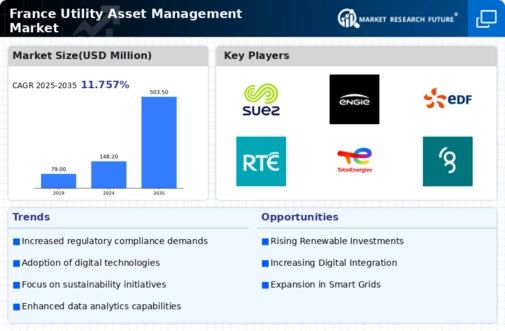Technological Advancements
Technological advancements are playing a pivotal role in shaping the utility asset-management market in France. The integration of Internet of Things (IoT) devices and artificial intelligence (AI) is revolutionizing how utilities manage their assets. These technologies enable real-time monitoring and predictive maintenance, which can significantly reduce operational costs. For example, the adoption of smart meters has increased by over 30% in the last two years, allowing utilities to optimize their asset management strategies. Furthermore, the market is expected to witness a surge in investments, with projections indicating an increase of around €1 billion in technology spending by 2027. This trend suggests that utilities are prioritizing technological innovation to enhance efficiency and reliability in the utility asset-management market.
Regulatory Compliance Pressure
The utility asset-management market in France is currently experiencing heightened pressure from regulatory compliance requirements. The French government has implemented stringent regulations aimed at enhancing operational efficiency and environmental sustainability. This has led to increased investments in asset management technologies, as utilities strive to meet compliance standards. For instance, the implementation of the Energy Transition Law mandates utilities to adopt innovative asset management practices. Consequently, the market is projected to grow at a CAGR of approximately 6.5% over the next five years, driven by the need for compliance with evolving regulations. Utilities are increasingly focusing on integrating advanced analytics and data management systems to ensure adherence to these regulations, thereby enhancing their operational capabilities in the utility asset-management market.
Aging Infrastructure Challenges
The aging infrastructure of utility assets poses a significant challenge for the utility asset-management market in France. Many utilities are grappling with outdated systems that require substantial investment for upgrades and maintenance. Reports indicate that approximately 40% of France's energy infrastructure is over 30 years old, leading to increased operational risks and inefficiencies. As a result, utilities are compelled to adopt comprehensive asset management strategies to address these challenges. This includes prioritizing investments in modernization and rehabilitation projects, which are projected to exceed €5 billion by 2030. The focus on upgrading aging infrastructure is likely to drive growth in the utility asset-management market, as utilities seek to enhance reliability and service quality.
Consumer Demand for Transparency
Consumer demand for transparency is increasingly influencing the utility asset-management market in France. As customers become more aware of their energy consumption and its environmental impact, they are demanding greater visibility into utility operations. This shift is prompting utilities to adopt more transparent asset management practices, including enhanced reporting and communication strategies. Surveys indicate that over 70% of consumers prefer utilities that provide clear information about their asset management processes. In response, utilities are investing in customer engagement platforms and data analytics tools to meet these expectations. This trend is likely to foster a more customer-centric approach in the utility asset-management market, ultimately driving innovation and efficiency.
Investment in Renewable Energy Sources
Investment in renewable energy sources is significantly impacting the utility asset-management market in France. The French government has set ambitious targets for increasing the share of renewables in the energy mix, aiming for 40% by 2030. This transition necessitates a reevaluation of asset management strategies to accommodate the integration of renewable technologies. Utilities are increasingly focusing on optimizing their asset portfolios to include solar, wind, and other renewable sources. Reports suggest that investments in renewable energy infrastructure could reach €10 billion by 2025, reflecting a strong commitment to sustainability. This shift not only enhances the resilience of the energy grid but also drives growth in the utility asset-management market as utilities adapt to new energy paradigms.




















Leave a Comment